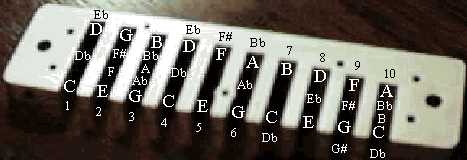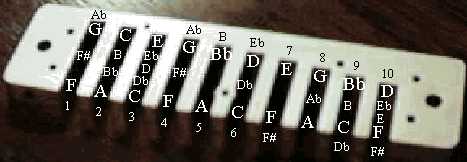Post by Admin on Dec 27, 2013 13:05:55 GMT -5
Note Layout
Here are pictures of a harp comb that shows where the notes are in a C and an F diatonic harmonica.
The holes are numbered 1-10, and the position of the hole number indicates the low note in each hole. The blow notes are shown in the hole chambers toward the front edge of the comb, and the draw notes are shown at the rear of the chambers. The notes in between the blow and draw notes in the chambers are the normal bent notes available in each hole. The notes shown outside the chambers are the overbends, consisting of overblows in holes 1-6 and overdraws in holes 7-10. Note that overbends are available in all holes, but only those that add unique notes have been shown.
The discontinuous line of hole numbers is shown to emphasize the point that the note relationships invert at hole 7. That is, on holes 1-6 the blow notes are lower than the draw notes--but on holes 7-10 the draw notes are lower than the blow notes.

Most players who advance beyond the beginner level play in 2nd position 80%-95% of the time. (Playing in 2nd position means the tonic note is the 2 draw, which is a 5th higher than the key of the harmonica.) So, to think in the generic key of C when playing in 2nd position, you use the key of F harmonica. Here is the note layout of a key of F harmonica

Another nice thing to see explicitly, instead of digging it out of other charts, is how to play the same note at different places on the harp. The range of a 10 hole diatonic is 3 octaves, so I've divided the table into Low, Mid, and Hi to correspond to these octaves.
C Harp Note Location
Note Low Med Hi
C 1> 4> 7>/10>
Db 1' 4' 7#/10#
D 1 4 8
Eb 1># 4># 8>'
E 2> 5> 8>
F 2" 5 9
F# 2' 5># 9>'
G 2|3> 6> 9>
Ab 3"' 6' 9#
A 3" 6 10
Bb 3' 6># 10>"
B 3 7 10>'
F Harp Note Location
Note Low Med Hi
F 1> 4> 7>/10>
F# 1' 4' 7#/10#
G 1 4 8
Ab 1># 4># 8>'
A 2> 5> 8>
Bb 2" 5 9
B 2' 5># 9>'
C 2|3> 6> 9>
Db 3"' 6' 9#
D 3" 6 10
Eb 3' 6># 10>"
E 3 7 10>'
These next tables show the holes, blow and draw, and the associated notes on C and F harps
C Harp Notes by Hole
Hole Blow Draw
1 C D
2 E G
3 G B
4 C D
5 E F
6 G A
7 C B
8 E D
9 G F
10 C A
F Harp Notes by Hole
Hole Blow Draw
1 F G
2 A C
3 C E
4 F G
5 A Bb
6 C D
7 F E
8 A G
9 C Bb
10 F D
Here are pictures of a harp comb that shows where the notes are in a C and an F diatonic harmonica.
The holes are numbered 1-10, and the position of the hole number indicates the low note in each hole. The blow notes are shown in the hole chambers toward the front edge of the comb, and the draw notes are shown at the rear of the chambers. The notes in between the blow and draw notes in the chambers are the normal bent notes available in each hole. The notes shown outside the chambers are the overbends, consisting of overblows in holes 1-6 and overdraws in holes 7-10. Note that overbends are available in all holes, but only those that add unique notes have been shown.
The discontinuous line of hole numbers is shown to emphasize the point that the note relationships invert at hole 7. That is, on holes 1-6 the blow notes are lower than the draw notes--but on holes 7-10 the draw notes are lower than the blow notes.

Most players who advance beyond the beginner level play in 2nd position 80%-95% of the time. (Playing in 2nd position means the tonic note is the 2 draw, which is a 5th higher than the key of the harmonica.) So, to think in the generic key of C when playing in 2nd position, you use the key of F harmonica. Here is the note layout of a key of F harmonica

Another nice thing to see explicitly, instead of digging it out of other charts, is how to play the same note at different places on the harp. The range of a 10 hole diatonic is 3 octaves, so I've divided the table into Low, Mid, and Hi to correspond to these octaves.
C Harp Note Location
Note Low Med Hi
C 1> 4> 7>/10>
Db 1' 4' 7#/10#
D 1 4 8
Eb 1># 4># 8>'
E 2> 5> 8>
F 2" 5 9
F# 2' 5># 9>'
G 2|3> 6> 9>
Ab 3"' 6' 9#
A 3" 6 10
Bb 3' 6># 10>"
B 3 7 10>'
F Harp Note Location
Note Low Med Hi
F 1> 4> 7>/10>
F# 1' 4' 7#/10#
G 1 4 8
Ab 1># 4># 8>'
A 2> 5> 8>
Bb 2" 5 9
B 2' 5># 9>'
C 2|3> 6> 9>
Db 3"' 6' 9#
D 3" 6 10
Eb 3' 6># 10>"
E 3 7 10>'
These next tables show the holes, blow and draw, and the associated notes on C and F harps
C Harp Notes by Hole
Hole Blow Draw
1 C D
2 E G
3 G B
4 C D
5 E F
6 G A
7 C B
8 E D
9 G F
10 C A
F Harp Notes by Hole
Hole Blow Draw
1 F G
2 A C
3 C E
4 F G
5 A Bb
6 C D
7 F E
8 A G
9 C Bb
10 F D

